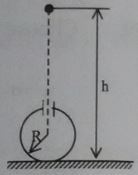How many will succeed?
 Electrically charged drops of mercury fall from an altitude
into a spherical metal vessel of radius
in the upper part of which there is a small opening. The mass of each drop is
and the charge of the drop is
. The number
of the last drop that can still enter the sphere is
. Then what is the value of
?
Electrically charged drops of mercury fall from an altitude
into a spherical metal vessel of radius
in the upper part of which there is a small opening. The mass of each drop is
and the charge of the drop is
. The number
of the last drop that can still enter the sphere is
. Then what is the value of
?
The answer is 2.
This section requires Javascript.
You are seeing this because something didn't load right. We suggest you, (a) try
refreshing the page, (b) enabling javascript if it is disabled on your browser and,
finally, (c)
loading the
non-javascript version of this page
. We're sorry about the hassle.
With each charge that enters the metallic sphere, a radially outward electric field starts building up. ( since charge is positive)
When the force due to the electric field at the opening of the sphere balances the gravitational force on the charged particle, charges would remain suspended and no new charge shall enter.
Let n be the number of the last charge that enters the sphere. Then net charge of sphere at that time is nq. Therefore, electric field at that time at the opening of the sphere is (1 / 4 pi epsilon) nq/ R^2
Since, F = qE ; force on a charged particle near spherical opening is q * (1/4 pi epsilon) nq / R^2. This force should be equal to mg. Also R= h-R , R^2 = R ( h - R ). Compute the value of n from the above equations.